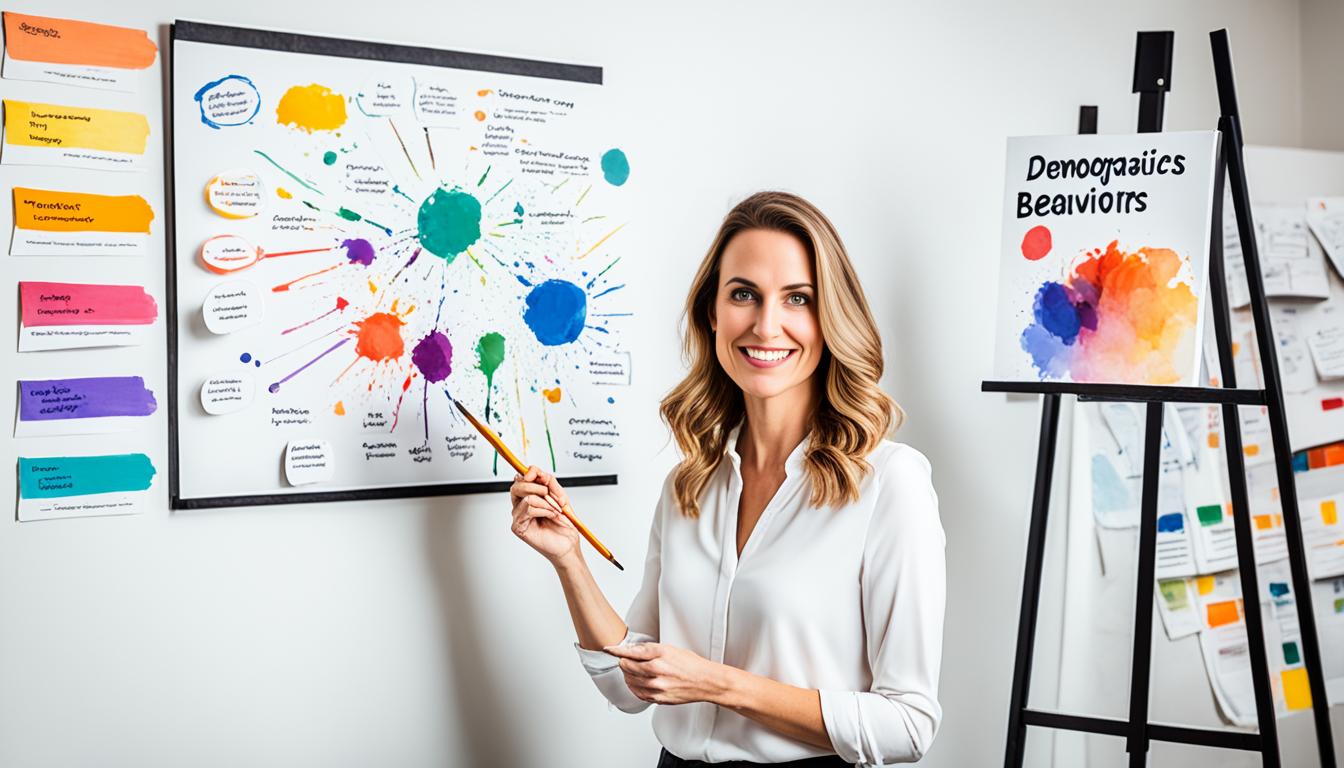
From Data to Personas: Understanding Your Audience

Have you ever wondered how successful marketers seem to effortlessly connect with their target audience? How do they know exactly what messages to deliver and which channels to use? The answer lies in their deep understanding of their audience through marketing buyer personas.
Creating data-driven buyer personas allows you to go beyond basic audience analysis and enter the realm of personalized marketing strategies. By diving into the nuances of your audience’s needs, preferences, and pain points, you can craft targeted messaging, create relevant content, and engage with your customers on a whole new level.
So how can you unlock the power of marketing buyer personas? Let’s explore the process of creating personas, understanding their importance, and the various methods you can use to know your audience better. It’s time to transform your marketing efforts and create an impactful connection with your target market.
Key Takeaways:
- Marketing buyer personas provide a deep understanding of your audience’s needs and preferences
- Creating data-driven buyer personas enables personalized marketing strategies
- Knowing your audience helps craft targeted messaging and relevant content
- Understanding audience challenges allows for improved product development and customer support
- Continuous audience analysis and feedback monitoring ensure effective engagement
What are Marketing Personas?
Marketing personas are composite sketches of key segments of your audience. They are not meant to represent one specific person but rather reflect the characteristics and needs of a particular group. These personas help you understand and connect with your target market by creating targeted messaging and content.
It is important to have multiple personas for different types of customers to ensure your marketing efforts are personalized and effective. These personas can go beyond just buyers and also include detractors, influencers, and anti-personas.
By understanding your audience through marketing personas, you can gain valuable insights into their motivations, pain points, and preferences. This knowledge allows you to tailor your marketing strategies and create content that resonates with each segment of your target market.
“Marketing personas provide a window into the lives and needs of your audience, helping you connect with them on a deeper level.” – Sarah Smith, Marketing Expert
Connecting with Your Target Market
When you have a clear understanding of your audience segments through marketing personas, you can develop targeted messaging that speaks directly to their needs and aspirations. You can craft content that solves their problems, provides value, and resonates with their interests.
- Identify the pain points and challenges your target market faces and address them in your messaging.
- Show how your product or service can fulfill their desires and help them reach their goals.
- Speak their language and use their preferred channels of communication to effectively engage with them.
By connecting with your target market through personalized marketing efforts, you can build trust, loyalty, and long-lasting relationships.
The Power of Personalization
Marketing personas enable you to deliver personalized experiences to your audience. By understanding their preferences, you can tailor your messaging, offers, and recommendations to match their unique needs and desires.
- Create targeted marketing campaigns that speak directly to each persona’s interests and motivations.
- Segment your email lists to send relevant content and offers to each group.
- Customize your website and landing pages to align with the needs and preferences of each persona.
In today’s crowded marketplace, personalization is key to standing out from the competition and establishing a strong connection with your audience.
Steps to Creating Marketing Personas
Creating marketing personas involves a structured process that includes four main steps: quantitative analysis, qualitative analysis, drafting the persona, and socializing the persona. Each step plays a crucial role in developing accurate and effective personas to guide your marketing strategies. Let’s explore each step in detail:
1. Quantitative Analysis
In the first step, quantitative analysis, you collect and analyze data about your customers to understand your key customer segments. This includes information such as company demographics, revenue, and engagement with your product or service. By examining these quantitative metrics, you can identify patterns and trends that will inform the development of your personas. This data-driven approach provides a solid foundation for understanding your audience.
2. Qualitative Analysis
The next step in creating marketing personas is qualitative analysis. This involves conducting customer interviews and gathering feedback to gain deeper insights into their needs, challenges, and motivations. Through qualitative research methods such as surveys, focus groups, or one-on-one interviews, you can capture valuable information that goes beyond the numbers. These qualitative insights add a human touch to your personas, allowing you to understand the emotions and aspirations of your target audience.
3. Drafting the Persona
Once you have collected both quantitative and qualitative data, it’s time to draft the persona. A persona is like a detailed profile of a specific segment of your target market. It represents the characteristics, behaviors, goals, and pain points of your ideal customer. When drafting the persona, use the information gathered from the previous steps to create a fictional but realistic representation of your target audience. Think about their demographics, personal background, professional role, and psychographic traits. The persona should be comprehensive, providing a clear picture of who your audience is.
4. Socializing the Persona
The final step in creating marketing personas is socializing the persona. This involves sharing and refining the persona with key stakeholders such as marketing teams, sales teams, and product managers. By involving multiple perspectives, you can ensure alignment and understanding across departments. The persona can serve as a reference point for decision-making and strategy development. Socializing the persona also allows for feedback and adjustments, ensuring that the persona accurately reflects your target audience.
By following these four steps – quantitative analysis, qualitative analysis, drafting the persona, and socializing the persona – you can create well-rounded marketing personas that truly represent your target audience. These personas will serve as guiding tools for your marketing strategies, helping you tailor your messaging, reach your audience, and create content that resonates with them.

| Benefits of Creating Marketing Personas | Steps to Creating Marketing Personas |
|---|---|
|
|
The Importance of Knowing Your Audience
Knowing your audience is crucial for tailoring your content, providing specific service and support, and resolving the challenges they face. When you understand your audience, you can create tailor-made content that resonates with them and addresses their specific needs. By providing customized service and support, you can ensure a positive customer experience and build trust and loyalty.
Understanding your audience’s challenges also allows you to resolve them efficiently by improving your products or services to better meet their needs. By identifying their pain points and addressing them directly, you can strengthen your position in the market and attract a loyal customer base.
By knowing your audience, you are able to unlock valuable insights that help you make informed business decisions and fuel your growth.
Moreover, when you know your audience well, you can go beyond surface-level demographics and truly understand their desires, aspirations, and struggles. This deeper understanding enables you to develop holistic solutions that meet their requirements and exceed their expectations. By going the extra mile to provide personalized experiences, you are more likely to create loyal customers who will advocate for your brand.
Building long-lasting relationships with your customers is a key advantage of knowing your audience. By being attentive to their needs and expectations, you foster a sense of trust and loyalty that encourages repeat business and positive word-of-mouth referrals.
Overall, by intimately knowing your audience, you can tailor your marketing strategies to reach and engage with them effectively, creating a sustainable competitive advantage in your industry.
How to Know Your Audience
Understanding your audience is crucial for effective marketing strategies. By getting to know your audience better, you can tailor your messaging and create content that truly resonates with them. Here are several ways to gain insights into your audience:
- Review Data and Analytics:
- Analyze Previous Successes:
- Create Buyer Personas:
- Conduct Surveys:
- Monitor Competitor Strategies:
- Pay Attention to Audience Feedback:
- Experiment with Content and Updates:
Analyzing your current data and analytics provides valuable information about your customers’ behavior and preferences. By studying the data, you can identify trends and patterns that help you understand your audience on a deeper level. This knowledge allows you to develop targeted strategies that effectively engage your audience.
Examining your previous successes among your audience is a great way to understand what is working well for them. By analyzing successful campaigns, content, or products, you can identify common factors that resonate with your audience. This information provides valuable insights for future marketing efforts.
Developing buyer personas helps you understand the needs and wants of your audience. By creating detailed profiles that represent different segments of your target market, you can better target and engage each group effectively. Take into account demographic, psychographic, and behavioral data to create comprehensive buyer personas.
Surveys are a powerful tool for gathering specific feedback and insights from your audience. Create surveys that ask targeted questions about their preferences, pain points, and expectations. The data collected from surveys provides valuable guidance for improving products, services, and overall customer experience.
Keep an eye on your competitors’ marketing strategies and how they target your shared audience. This will help you identify their successful approaches and gain insights into what resonates with your audience. Use this information to refine and differentiate your own marketing efforts.
Actively listen to your audience through comments, feedback, and engagements. This valuable input allows you to understand their preferences and pain points. By addressing their feedback and providing solutions to their challenges, you can strengthen your relationship with your audience and foster customer loyalty.
Don’t be afraid to try new ideas and experiment with different content formats or updates. This allows you to gather feedback from your audience and gain insights into what resonates with them. Through experimentation, you can continuously improve your marketing strategies and keep your audience engaged.
By following these strategies, you can develop a deeper understanding of your audience and create marketing campaigns that truly connect with them. Remember, knowing your audience is the key to success in the ever-evolving digital landscape.
Reviewing Data and Analytics
When it comes to understanding your audience, data and analytics play a vital role. By reviewing the data and analytics from your marketing efforts, you can gain valuable insights into your customers’ behavior and preferences. This information empowers you to optimize your strategies, tailor your content, and deliver a more personalized experience that resonates with your audience.
To begin, collecting customer information is essential. This includes demographic data, such as age, location, and gender, as well as information like revenue and engagement with your products or services. By gathering this data, you can create a comprehensive view of your audience and identify key trends and patterns.
Once you have collected the necessary data, the next step is to analyze customer behavior. By examining how your customers interact with your website, emails, social media, and other touchpoints, you can gain valuable insights into their preferences and interests. This analysis allows you to identify which marketing channels are most effective and which content resonates the most with your audience.
With a deep understanding of your customers’ behavior and preferences, you can then identify powerful insights. These insights may include discovering new opportunities to reach your audience, understanding their pain points and challenges, or uncovering emerging trends in the market. Armed with this knowledge, you can make data-driven decisions that drive your marketing efforts forward.
Benefits of Reviewing Data and Analytics:
- Make informed decisions: Data and analytics provide the insights necessary to make informed decisions about your marketing strategies and content creation.
- Optimize targeting: By understanding your audience’s behavior, you can optimize your targeting efforts and deliver the right message to the right person at the right time.
- Improve customer experience: Data and analytics reveal important insights about your audience’s preferences, allowing you to improve the overall customer experience and increase satisfaction.
- Identify trends: Analyzing customer behavior helps you identify trends in the market, enabling you to stay ahead of the competition and adapt your strategies accordingly.
By continuously reviewing and analyzing data and analytics, you can stay connected with your audience’s evolving needs and preferences. This ongoing process empowers you to optimize your marketing strategies, engage your audience more effectively, and build long-lasting relationships with your customers.

| Benefits of Reviewing Data and Analytics | Examples |
|---|---|
| Make informed decisions | Use data to determine the most effective marketing channels and allocate resources accordingly. |
| Optimize targeting | Segment your audience based on their preferences and behavior to deliver personalized marketing messages. |
| Improve customer experience | Identify pain points in the customer journey and optimize the user experience to increase satisfaction. |
| Identify trends | Analyze customer behavior to identify emerging trends in the market and adapt your strategies accordingly. |
Leveraging Previous Successes
Understanding your audience’s needs and preferences is key to maintaining effective strategies that resonate with them and drive results. By analyzing previous successes, you can gain valuable insights that help you cater to your audience more effectively.
When you leverage previous successes, you tap into a wealth of knowledge about what works well for your audience. It allows you to identify patterns and trends that contribute to your audience’s satisfaction and engagement. By understanding what has resonated with your audience in the past, you can align your strategies to meet their needs and surpass their expectations.
One effective way to leverage previous successes is by analyzing data and feedback from your audience. Look at patterns in customer behavior, such as popular product features, preferred content formats, or successful marketing campaigns. Identify which messaging or strategies have resulted in high engagement or conversion rates.
For example, if you run an online clothing store and notice that certain product categories consistently receive high sales and positive customer reviews, you can leverage this information to prioritize those categories in your marketing efforts. Additionally, you can identify the key features or design elements that attracted customers and incorporate them into future product development or marketing campaigns.
Another way to leverage previous successes is by learning from industry leaders and competitors. Monitor their strategies and identify what has worked well in terms of audience engagement, content creation, or customer support. This information can provide valuable insights into what your audience responds to and provide inspiration for your own strategies.
Case Study: Leveraging Social Media Engagement
“Our previous successes in social media engagement taught us the importance of authentic storytelling. By sharing relatable stories and experiences, we fostered a deeper connection with our audience and increased brand loyalty. Leveraging this insight, we continued to create compelling content that resonated with our audience’s values and interests, resulting in increased engagement and website traffic.”
By leveraging previous successes, you can maintain effective strategies that align with your audience’s evolving needs. Continuously analyze and learn from past achievements to create compelling campaigns, tailored content, and innovative solutions that drive results.
| Benefits of Leveraging Previous Successes: | How to Leverage Previous Successes: |
|---|---|
| 1. Understand audience preferences | 1. Analyze data and feedback from your audience |
| 2. Increase audience engagement | 2. Learn from industry leaders and competitors |
| 3. Align strategies with audience needs | 3. Incorporate successful elements into future campaigns |
| 4. Drive better results | 4. Continuously analyze and learn from past achievements |
When leveraged effectively, previous successes can be a powerful tool in understanding your audience’s needs and maintaining strategies that consistently drive successful outcomes. Take the time to review and learn from your past achievements, and use these insights to create tailored experiences that keep your audience engaged and satisfied.
Creating Buyer Personas
Understanding your audience’s needs and wants is crucial for effective marketing. One powerful tool for gaining this understanding is creating buyer personas. These personas provide a detailed profile of your target customers, encompassing their demographics, psychographics, and behaviors. By developing a deep understanding of these personas, you can better target and convert your audience, building long-lasting relationships in the process.
Buyer personas help your entire business stay focused on your target audience. With a clear picture of who your customers are, you can tailor your marketing strategies and content to their specific needs and preferences. By speaking directly to the pain points and aspirations of your buyer personas, you can create personalized experiences that resonate with them on a deeper level.

Understanding Audience Needs
Creating buyer personas allows you to gain a deep understanding of your audience’s needs. By diving into their demographics and psychographics, you can uncover their motivations, goals, and challenges. This insight enables you to develop products and services that directly address those needs, positioning your business as the solution they’ve been searching for.
Targeting and Converting Your Audience
With buyer personas in hand, you can craft targeted marketing campaigns that speak directly to your audience. By understanding their pain points, aspirations, and decision-making processes, you can create messaging and content that resonates with them on an emotional level. This emotional connection increases the likelihood of conversion, as your audience sees your brand as a trusted ally in addressing their needs.
Building Long-lasting Relationships
Building long-lasting relationships with your audience is essential for sustainable growth. Buyer personas not only help you attract new customers but also enable you to nurture and retain existing ones. By personalizing your interactions, providing relevant content and offers, and consistently delivering value, you can cultivate loyalty and turn customers into brand advocates.
Creating buyer personas is like peering into the minds and hearts of your target audience. With this deep understanding, you can connect with them in a meaningful way, guiding them along their customer journey and building lasting bonds.
By investing the time and effort in creating buyer personas, you can unlock invaluable insights into your audience’s needs, target them effectively, and build long-lasting relationships. Continuously reevaluating and refining your personas allows you to stay in touch with your audience as their needs evolve, ensuring your marketing strategies remain relevant and impactful.
Conducting Surveys
Surveys are a powerful tool that enables you to gather specific feedback from your audience and gain valuable insights into their preferences, pain points, and suggestions for improvement. By conducting surveys, you can make data-driven decisions to improve your products and services, and better understand the preferences of your audience.
Why Conduct Surveys?
Surveys offer a direct line of communication between you and your audience, providing an opportunity to gather targeted feedback on various aspects of your business. By reaching out to your audience through survey questionnaires, you can gain valuable insights that help you:
- Gather specific feedback on your products and services, allowing you to understand what works well and areas for improvement.
- Identify your audience’s preferences, enabling you to tailor your offerings to better meet their needs.
- Gain a deeper understanding of your audience’s pain points, allowing you to address them more effectively.
- Collect suggestions and ideas for future product development and improvements.
By conducting surveys and actively listening to your audience, you can enhance your products and services, ensuring they align with your customers’ needs and preferences.
“Surveys provide an invaluable opportunity to connect with your audience, understand their preferences, and make informed decisions that drive success.”
Best Practices for Conducting Surveys:
When creating and conducting surveys, it is important to follow best practices to maximize response rates and gather meaningful data:
- Create clear and concise survey questions. Use language that is easily understandable and avoid leading questions.
- Keep surveys short and focused. Respect your audience’s time by only asking relevant questions.
- Offer multiple response options to ensure inclusivity and accuracy of data.
- Consider incentives to encourage participation, such as a chance to win a prize or access to exclusive content.
- Use a mix of qualitative and quantitative questions to gain comprehensive insights.
- Pilot test your survey before distributing it to ensure clarity and identify any potential issues.
- Advertise your survey through various channels, such as email newsletters, social media, and your website, to reach a wider audience.
- Ensure the confidentiality and anonymity of survey respondents to encourage honest and unbiased feedback.
- Analyze survey results systematically to identify meaningful trends and patterns.
By following these best practices, you can conduct surveys that yield accurate and actionable insights, empowering you to make informed decisions to improve your products, services, and overall audience experience.
| Benefits of Conducting Surveys: | Best Practices for Conducting Surveys: |
|---|---|
|
|
Conducting surveys empowers you to gather specific feedback, gain a deeper understanding of your audience, and make data-driven improvements to your products and services. By actively listening to your audience’s preferences and addressing their needs, you can build stronger relationships and drive long-term success.
Monitoring Competitors and Audience Feedback
Monitoring your competitors and audience feedback is essential to keep your finger on the pulse of market trends and identify audience preferences. By observing your competitors, you can gain valuable insights into their strategies and tactics, enabling you to identify gaps or opportunities within the market. In turn, this knowledge empowers you to refine your own marketing efforts and product development to better serve your audience and stay ahead of the competition.
Understanding Market Trends
To effectively navigate the ever-evolving landscape, it is crucial to understand the market trends shaping your industry. By continuously monitoring your competitors, you can stay informed about emerging trends, new product offerings, and evolving customer expectations. This information allows you to adapt your marketing strategies, innovate your offerings, and remain relevant in a rapidly changing market.
Identifying Audience Preferences
Monitoring audience feedback, comments, and engagements provides valuable insights into your audience’s preferences, pain points, and satisfaction with your products or services. By actively listening to your audience, you can gain a deeper understanding of what resonates with them, allowing you to tailor your messaging and offerings accordingly. This enables you to deliver a more personalized and engaging experience, fostering stronger connections and long-term relationships with your customers.
“To succeed, you must relentlessly monitor your competitors and actively listen to your audience. By doing so, you gain a competitive edge, spot opportunities, and create exceptional experiences that keep your audience coming back for more.”
| Benefits of Monitoring Competitors and Audience Feedback | Actions to Take |
|---|---|
| Gaining insights into market trends and industry developments | Regularly analyze competitor strategies and tactics |
| Identifying gaps or opportunities within the market | Conduct thorough competitive analysis |
| Understanding audience preferences, pain points, and satisfaction | Monitor audience feedback, comments, and engagements |
| Tailoring marketing efforts and product development | Adapt and innovate based on feedback and market trends |
| Building stronger connections and long-term relationships with customers | Create personalized experiences that resonate with your audience |
Conclusion
Understanding your audience through marketing buyer personas is crucial for creating tailored marketing strategies and effectively engaging with your target market. By gaining deep insights into your audience’s needs, preferences, and pain points, you can develop content, products, and services that truly resonate with them and drive tangible results.
Continuous monitoring and analysis of your audience’s behavior and feedback are essential to staying connected with their evolving needs and preferences. This invaluable information allows you to adapt your marketing strategies, refine your messaging, and ensure effective engagement with your audience.
By leveraging marketing buyer personas, you can build strong and long-lasting relationships with your audience. Tailoring your marketing efforts based on a deep understanding of your audience’s characteristics and motivations enables you to deliver personalized experiences and solutions that add value to their lives.
Remember, successful marketing is all about connecting with your audience on a deeper level. By incorporating marketing buyer personas and constantly striving for effective engagement, you can create targeted marketing strategies that drive meaningful connections and deliver exceptional results.





























